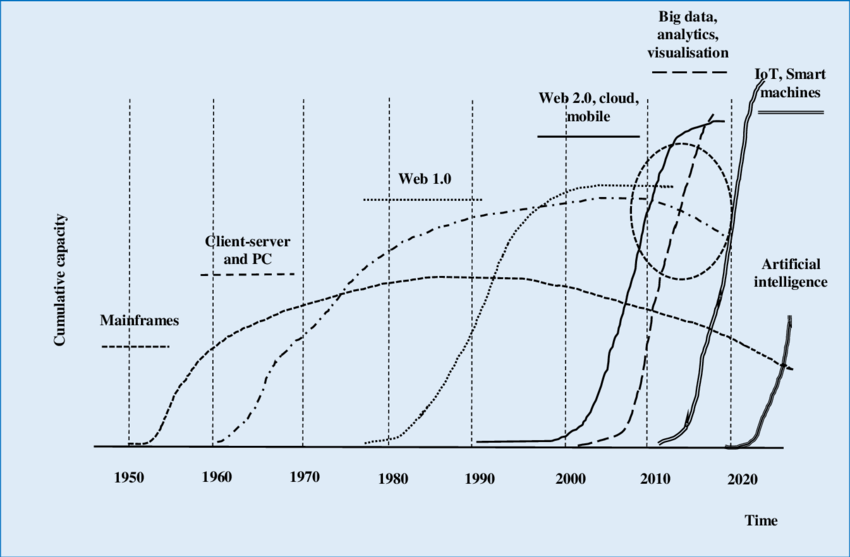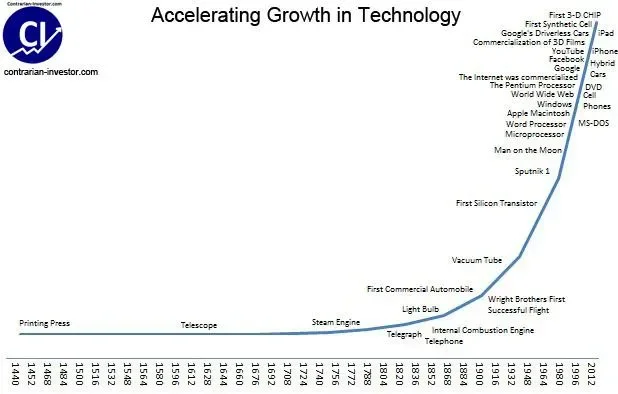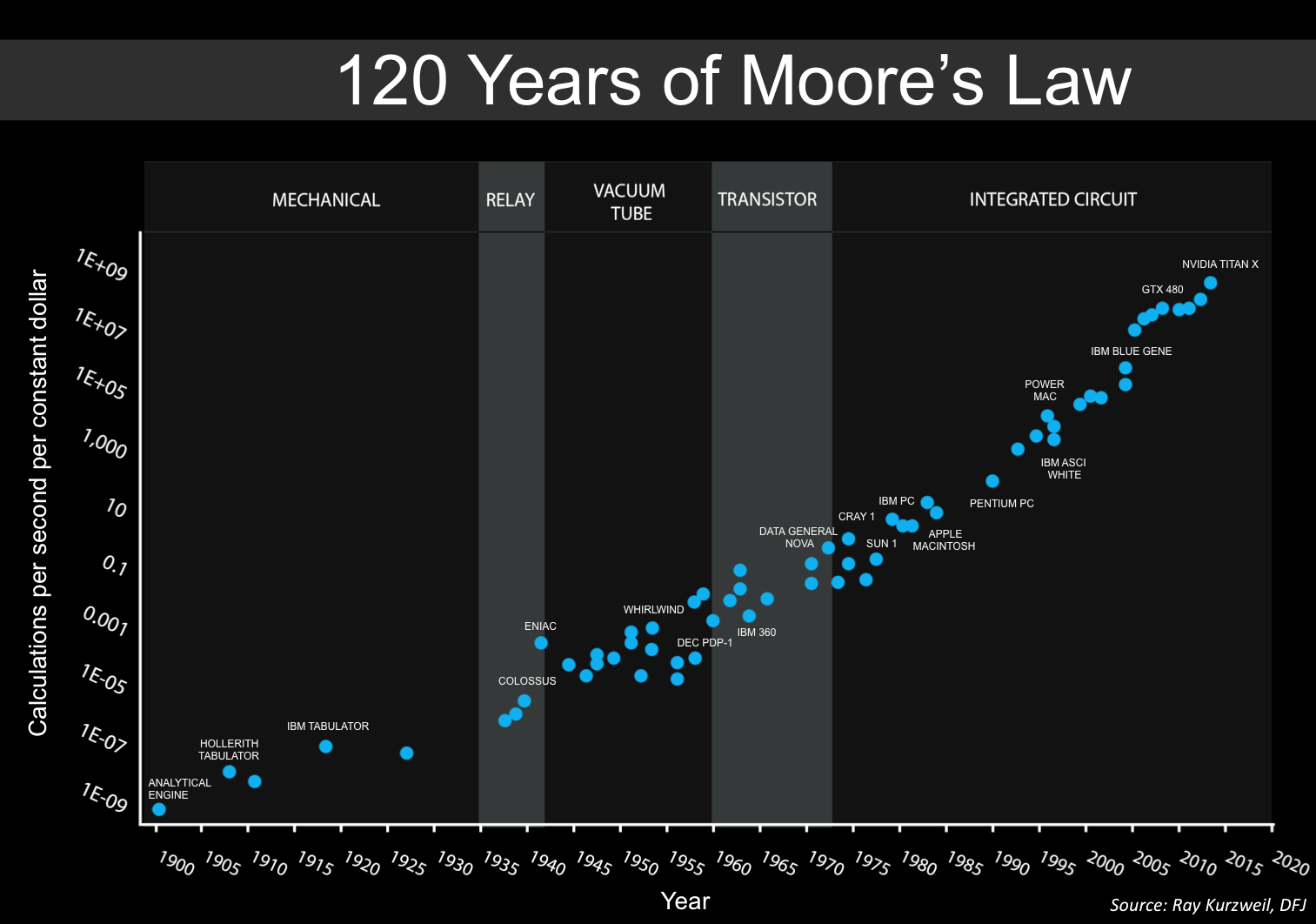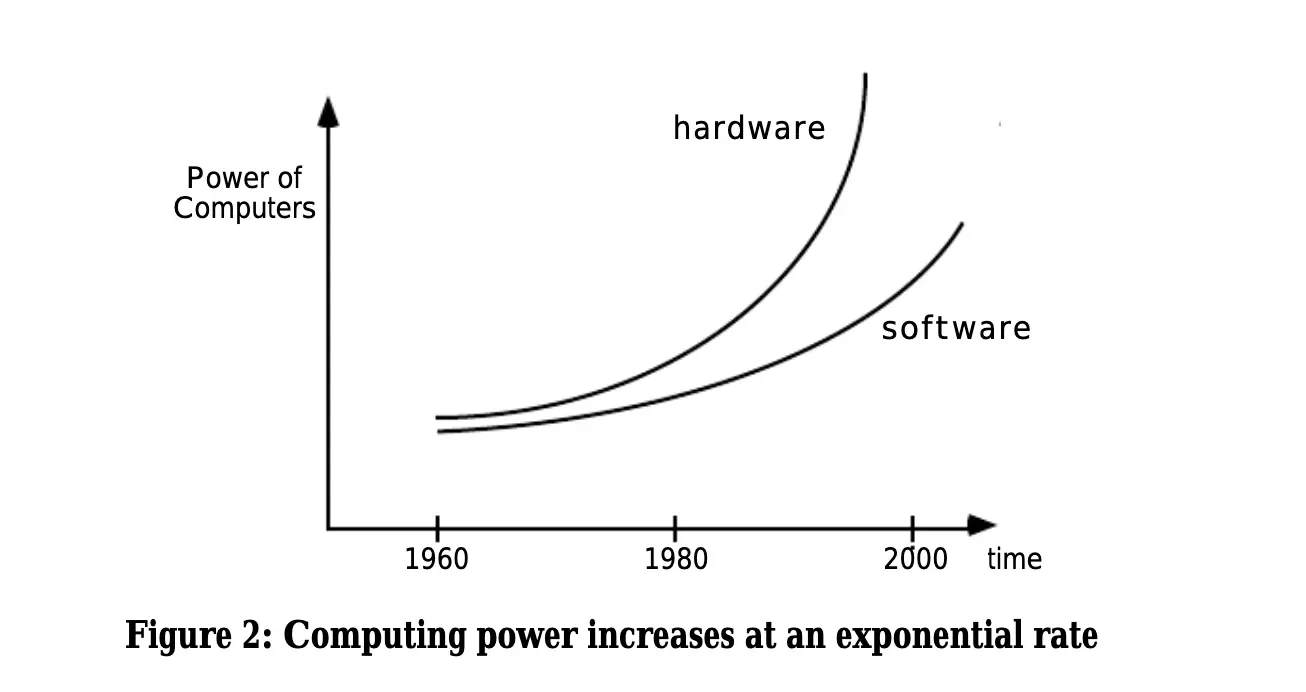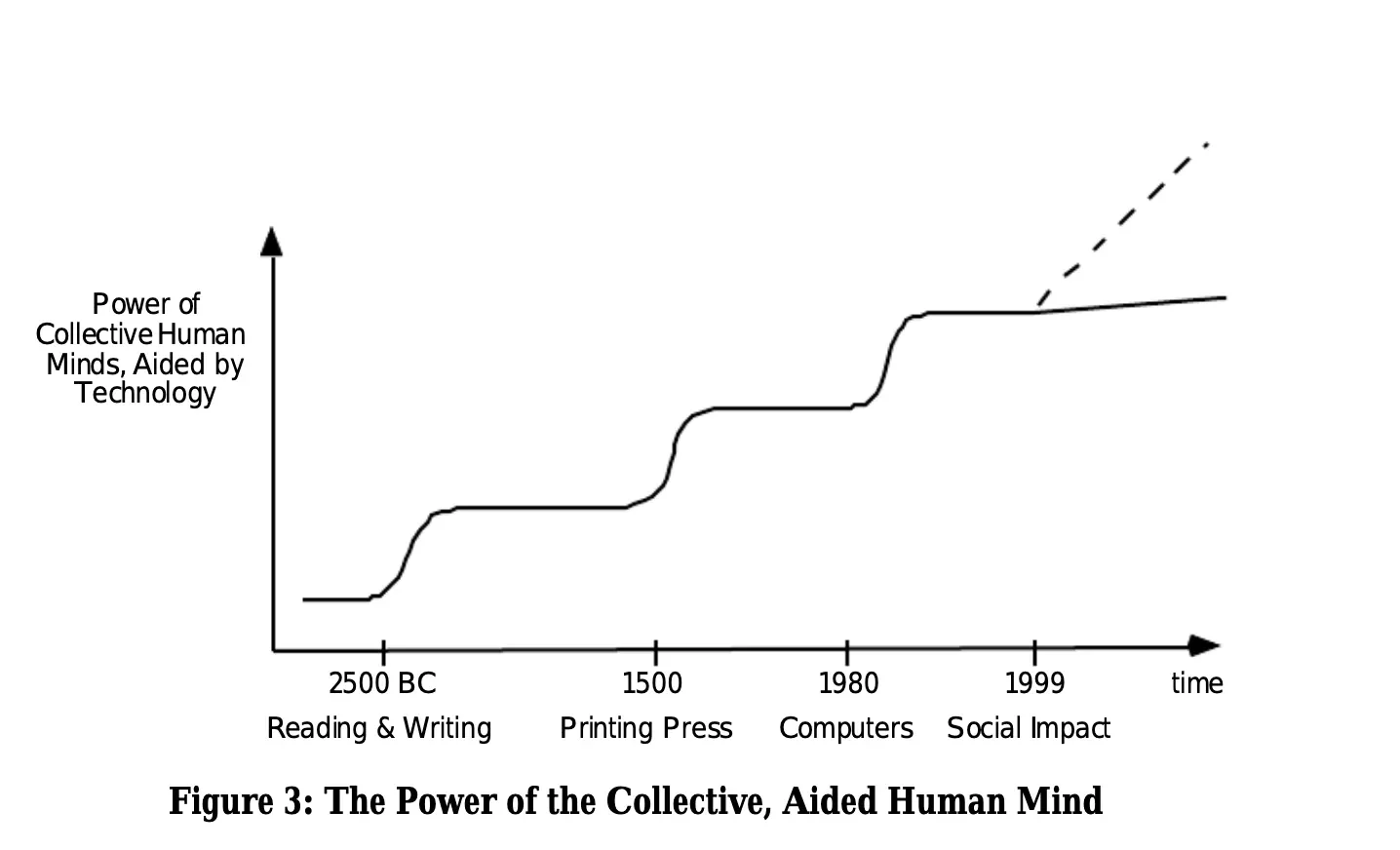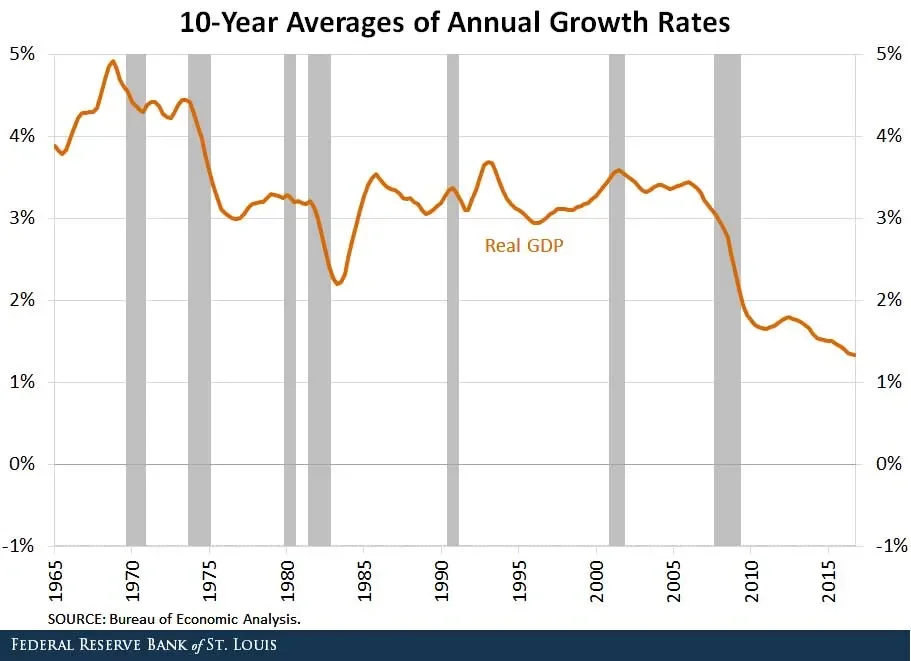We do not live in exponential times
All watched over by machines of loving grace
Any regular user of “the Linkedin” over the past couple of years will be aware that exponential growth is all around us as we accelerate into the AI-metaverse cybernetic meadow.
But your smartphone has more computing power than NASA used to land on the moon. So why does it still take the same 45 minutes to get across London that it took in 1970? Why are we still flying in aluminum tubes designed in the 1950s? And why hasn't worker productivity increased much despite decades of 'exponential' computing advances?
“The coming wave”
The “something’s coming” story is normally great for clicks. The exponential narrative is compelling, but the data tells a different story: one that changes everything about how we should think about progress and the future.
And yet this belief has been around for a while, and like the cavalry in the old movie coming over the horizon to the rescue, the action is going on, and we keep cutting to the soldiers coming, and back to the action, but the cavalry never seem to get any closer.
This essay looks at where does our perception of exponential growth come from, how fast do technologies actually get adopted, and proposes the idea that progress is not a linear path up and to the right, and then explores where our next technology triggers may come from?
The exponential argument
Let’s first look at the summary for the exponential acceleration argument.
Accelerating change refers to the idea that the pace of technological and social transformation is not just fast, but is itself speeding up over time. Ray Kurzweil popularized this notion through his "Law of Accelerating Returns," arguing that information technologies follow predictable exponential curves.
The theory extends beyond technology to encompass broader social, economic, and cultural changes. It is argued that innovations in artificial intelligence, biotechnology, nanotechnology, and other fields are not just advancing quickly, but are beginning to compound and reinforce each other, creating a cascade effect.
This acceleration is thought to be driven by factors like increased global connectivity, larger pools of researchers and inventors, better tools for collaboration and knowledge sharing, and the ability of new technologies to aid in the development of even newer technologies.
Sounds great right?
This graph has been doing the rounds for the last few years:
You will have seen a diagram that looks something like this before. Have a look at it. Are we really living in an era of accelerating technology growth? Is the difference between the microprocessor and the 3D chip really 3x the progress from the printing press to the landing on the moon?
I think we might be over-fitting the data here a little bit.
But Moore's Law...
Moore’s law is working pretty well with computer chips. But I would argue more computer chips does not necessarily mean more of everything else.
But does everything follow the same logarithmic projection?
Digital and AI researcher Gerhard Fischer wrote a paper in 1999, about the development of the internet. It’s called: “A Group Has No Head”.
Its core thesis is that
“conceptual frameworks and innovative systems in support of social interaction are a necessity rather than a luxury for our future information society”
and that while Moore’s Law shows a doubling in compute resource every 18 months it is
“one of the basic misunderstandings has been that while these technologies are necessary, they are not sufficient to allow humans to think previously unthinkable thoughts, to let them work more creatively and efficiently, to learn and understand more, and to collaborate more…”
So even though the technology is there, there are limitations driven by human ingenuity, capacity and collaboration. He then goes on to describe how the power of collective human minds rise in phased stages, driven by improvements in collaboration and coordination technology.
Progress is constrained by other factors than just the exponential growth in computing power. We also need our ability to connect, coordinate and control the hardware to also improve over time. And this takes time.
Reality check?
Let’s look at the counter point. Innovation over the past 30-40 years has been in information technology. A lot of everything else has stayed the same. In fact, economic growth is slowing down:
Here’s the graph of the GDP growth in the USA. Oh I hear you say what about the developing world? Well that’s slowing down too. Here’s the graph of global growth in roughly the same period
Global GDP growth has fallen from 4% to 2%, that's the difference between living standards doubling every 18 years versus every 35 years.
And the shift in “Developed” countries is even greater, falling from 5% annually to only 1%- 2% annually
Is this a parallax effect? Recent changes loom large in our experience while transformational changes from previous generations fade into historical background?
Those things that we have personal experience seem bigger and more consequential than things that are further away and we have no personal experience of? Just like Jurassic Park when you are looking at the T-Rex, objects in the mirror are closer than they appear
Counterpoint: Our grandparents
Let’s take a previous generation, outside of living memory where there were huge changes.
A poor family in 1912
These are people who have been alive in the past 100 years, the photo above was taken in 1912. The children probably died in around 1990, maybe 2000.
But no-one currently living will have directly experienced the changes they saw. What I would like to posit is that the changes in their lives were MORE consequential and larger than the changes in ours.
My grandparents generation
Born in 1916 In their lifetime we saw a massive change in quality of life and enormous technological progress
Toilet in house
Washing machine
International jet travel
Let’s go to the moon
Life expectancy +50%
Compared to our generation
Born in 1976 - In my lifetime we have seen the incredible growth of the internet
Library in my pocket
Massively more efficient commerce
Watch any TV show or movie at any time
Remote office work a possibility
Life expectancy +3%
Still no jetpacks
This chart shows the average weekly diet of one working class family from Oxfordshire in England in 1912. It was included in the book “How the Labourer Lives: A Study of the Rural Labour Problem” by B. Seebohm Rowntree and May Kendall, published in 1917.
The weekly diet of an Edwardian family
Compare it to your food today.
Are things always improving, and in fact the rate of that improvement is constantly accelerating? My grandfather went from horse-drawn carts to jet engines. I went from dial-up to fiber optic. Their generation gained 50% improvement in their expected life, ours gained 3%.
Which transformation was bigger?
How fast is change happening?
We think things are changing fast because we see them up close, but often we are witnessing incremental improvements.
Yes, we have smartphones and social media, but ask yourself: has your fundamental quality of life improved as much as someone going from no electricity to full electrification?
We've been digitising industrial-era innovations (communication, logistics, manufacturing) but not fundamentally transcending them.
My grandparents saw the creation of new physical capabilities; we've seen the optimization of existing ones.
My view is that the broad stroke of history over the past 300 years (ie the industrial revolution) is one of automation. Initially this related to mechanising energy and subsequent stages. The information technology revolution becomes the final act of industrialization rather than something entirely new.
The Industrial Revolution came in waves
A steam plough in 1912
At the risk of oversimplifying, we could think about four key phases of the industrial revolution : Mechanical => Production => Communication => Information
Phase 1 (1720s-1840s): Mechanizing Physical Power
Steam engines replace human/animal muscle power
Water wheels, textile machinery automate hand production
Abstraction: Human physical strength → mechanical force
Phase 2 (1840s-1920s): Systematizing Production
Assembly lines, interchangeable parts replace craft skills
Electricity enables precise, distributed mechanical control
Railways/telegraph abstract distance and time constraints
Abstraction: Human craft expertise → standardized systems
Phase 3 (1920s-1970s): Automating Communication
Mass production abstracts individual decision-making
Telephone networks, radio/TV abstract communication barriers
Corporations, bureaucracies systematize human organization
Abstraction: Human coordination → institutional systems
Phase 4 (1970s-2020s): Digitizing Information Processing
Computers replace human calculation and memory
Internet abstracts geographic/institutional boundaries
Software automates cognitive tasks (analysis, communication, transactions)
Abstraction: Human information processing → digital systems
The Evolutionary Model of Progress
Progress doesn't follow the smooth exponential curves we imagine. Instead, it mirrors biological evolution: long periods of stability punctuated by rapid transformation when trigger points are reached. This is the S-curve pattern that governs all technological change.
The Classic S-Curve Pattern:
Discovery Phase: Slow initial progress, high uncertainty, limited adoption
Rapid Deployment: Exponential growth once key barriers are overcome
Mass Adoption: Fast scaling across economy and society
Optimisation/Plateau: Incremental improvements, diminishing returns
Two Timescales of S-Curves
Short-Term Technology S-Curves (20-40 years)
Individual technologies follow remarkably consistent adoption patterns. Whether it's electricity, automobiles, television, or smartphones, the time from commercial introduction to mass adoption stays inside a 20-40 year window.
By the time normal people notice, we are towards the end, and everything seems to happen very fast.
40 year adoption windows of key tech changes of the 20th century
Long-Term Civilisational S-Curves (200+ years)
To build on this I would argue that larger transformations operate on multi-generational timescales. These represent fundamental shifts in how human societies organise energy, produce, and coordinate. The Industrial Revolution itself is one such mega-S-curve spanning roughly 300 years.
Starting with a “discovery phase” of harnessing power, and early mechanisation, deployment coming with mass production, and mass adoption happening during the middle of the 20th century, and a plateau since the 1970s, and digital enhancement of existing systems.
Why We Misperceive Progress
So why do we misperceive this progress?
Living Within One Phase: Most people experience only one part of a long S-curve during their lifetime. “Art is long, but life is short”...
Those who lived through 1940-1980 experienced rapid deployment and felt like progress was accelerating forever. Those living through 1980-2020 experienced optimization and mistake incremental improvement for continued acceleration.
The Plateau Problem: When you're at the top of an S-curve, small improvements feel significant because they're happening to systems you use daily. But you're actually experiencing diminishing returns, not acceleration.
Overlapping Curves: New S-curves often begin during the optimization phase of the previous one. Early internet development happened during the maturation of television and telephone systems. This creates confusion about which curve we're on.
The Great Stagnation
The declining GDP growth figures we've seen represent something deeper than economic cycles - they're symptoms of a broader productivity plateau that's been building since the 1970s. The disconnect is stark when you examine it closely.
Moore's Law has delivered exponential increases in computing power for decades, yet worker productivity growth has actually slowed during the same period. This is Solow's Productivity Paradox in action:
"You can see the computer age everywhere but in the productivity statistics."
We have more computational power in our pockets than NASA used to land on the moon, yet the average worker isn't dramatically more productive than they were in 1980.
Your grandparents witnessed the creation of fundamental physical infrastructure that transformed daily life: interstate highway systems that enabled suburban development and national commerce, electrical grids that powered industrial transformation, water treatment systems that eliminated waterborne diseases, airports that made global travel routine.
What equivalent infrastructure have we built since 1980? The honest answer is almost none.
Most of our "exponential" technologies are software layers running on top of the same physical infrastructure built 50-80 years ago.
We're still using: copper pipes from the 1940s, concrete highways from the 1930s, electrical grids from the 1900s, and aluminium aircraft designs from the 1950s. The 'digital revolution' is largely software optimisation running on 80-year-old physical infrastructure.
This explains why the digital revolution feels so transformative in our daily experience while delivering relatively modest productivity gains. We're experiencing the final optimisation phase of existing infrastructure rather than the creation of new foundational capabilities. It's the difference between building a new highway system and installing better traffic lights on existing roads.
The low hanging fruit has been eaten
Economist Tyler Cowen captured this phenomenon in his "Great Stagnation" thesis - that there has been a plateau now that the “low hanging fruit” of the industrial revolution has been captured, and now only harder problems remain
Cowen identified three major forms of easily captured gains that have been close to fully mined (in the USA):
Vast amounts of free, unused land that could be brought into production
Rapid invention from 1880 to 1940 that capitalized on scientific breakthroughs accumulated over previous centuries
Massive returns from basic education as we moved intelligent but uneducated populations through school and university systems.
There are potentially two further minor forms:
cheap fossil fuels
The strength of the American constitution.
Cowen concludes,
"You could say, 'The modern United States was built on five forms of low-hanging fruit, and at most only two of those are still with us.' “
Coda
So if we're not in exponential times, what comes next?
My argument is that we are currently experiencing a plateau in growth, and we perhaps have not yet fully culturally appreciated that slowdown, and we are at the station waiting for the next trigger point.
The current rise of populism, and the feeling of relative decline in our national and international politics could be our initial cultural realisation that we are on a plateau.
If we accept that significant trigger points can move us from periods of plateau to new levels of progress, then it's worth examining what drives those transformational moments and where the next ones might emerge.
If we're not accelerating exponentially, this changes everything about how we should invest, plan, and think about the future.
But it also raises a crucial question: what actually triggers the next wave of genuine transformation?
Part 2 of this essay explores the hidden patterns behind breakthrough technologies and where the next ones might emerge.



